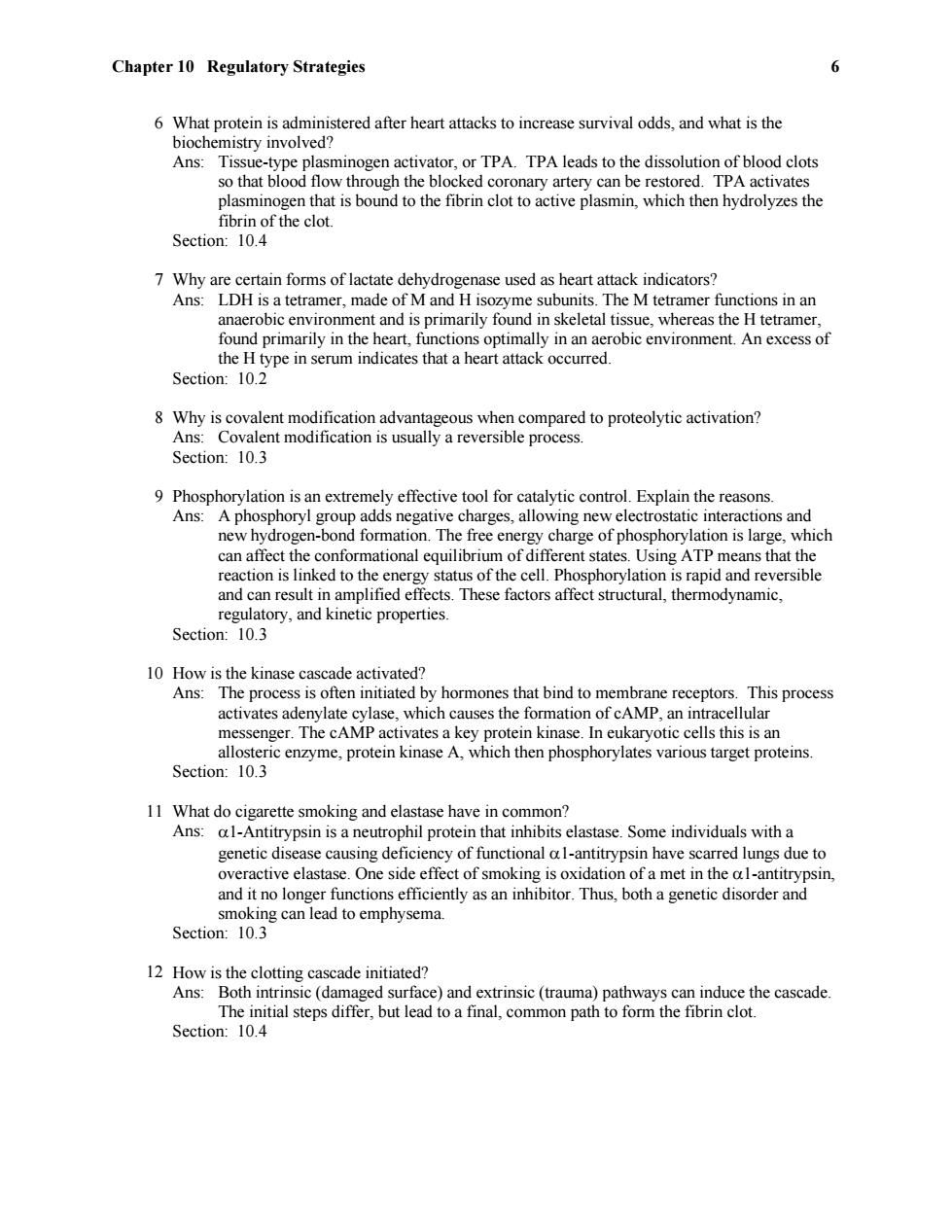正在加载图片...

Chapter 10 Regulatory Strategies 6 6 What protein is administered after heart attacks to increase survival odds,and what is the biochemistry involved? Ans:Tissue-type plasminogen activator,or TPA.TPA leads to the dissolution of blood clots so that blood flow through the blocked coronary artery can be restored.TPA activates plasminogen that is bound to the fibrin clot to active plasmin,which then hydrolyzes the fibrin of the clot. Section:10.4 7 Why are certain forms of lactate dehydrogenase used as heart attack indicators? Ans:LDH is a tetramer,made of M and H isozyme subunits.The M tetramer functions in an anaerobic environment and is primarily found in skeletal tissue,whereas the H tetramer, found primarily in the heart,functions optimally in an aerobic environment.An excess of the H type in serum indicates that a heart attack occurred. Section:10.2 8 Why is covalent modification advantageous when compared to proteolytic activation? Ans:Covalent modification is usually a reversible process. Section:10.3 9 Phosphorylation is an extremely effective tool for catalytic control.Explain the reasons. Ans:A phosphoryl group adds negative charges,allowing new electrostatic interactions and new hydrogen-bond formation.The free energy charge of phosphorylation is large,which can affect the conformational equilibrium of different states.Using ATP means that the reaction is linked to the energy status of the cell.Phosphorylation is rapid and reversible and can result in amplified effects.These factors affect structural,thermodynamic, regulatory,and kinetic properties. Section:10.3 10 How is the kinase cascade activated? Ans:The process is often initiated by hormones that bind to membrane receptors.This process activates adenylate cylase,which causes the formation of cAMP,an intracellular messenger.The cAMP activates a key protein kinase.In eukaryotic cells this is an allosteric enzyme,protein kinase A,which then phosphorylates various target proteins. Section:10.3 11 What do cigarette smoking and elastase have in common? Ans:a1-Antitrypsin is a neutrophil protein that inhibits elastase.Some individuals with a genetic disease causing deficiency of functional a l-antitrypsin have scarred lungs due to overactive elastase.One side effect of smoking is oxidation of a met in the al-antitrypsin, and it no longer functions efficiently as an inhibitor.Thus,both a genetic disorder and smoking can lead to emphysema. Section:10.3 12 How is the clotting cascade initiated? Ans:Both intrinsic(damaged surface)and extrinsic(trauma)pathways can induce the cascade The initial steps differ,but lead to a final,common path to form the fibrin clot. Section:10.4Chapter 10 Regulatory Strategies 6 6 What protein is administered after heart attacks to increase survival odds, and what is the biochemistry involved? Ans: Tissue-type plasminogen activator, or TPA. TPA leads to the dissolution of blood clots so that blood flow through the blocked coronary artery can be restored. TPA activates plasminogen that is bound to the fibrin clot to active plasmin, which then hydrolyzes the fibrin of the clot. Section: 10.4 7 Why are certain forms of lactate dehydrogenase used as heart attack indicators? Ans: LDH is a tetramer, made of M and H isozyme subunits. The M tetramer functions in an anaerobic environment and is primarily found in skeletal tissue, whereas the H tetramer, found primarily in the heart, functions optimally in an aerobic environment. An excess of the H type in serum indicates that a heart attack occurred. Section: 10.2 8 Why is covalent modification advantageous when compared to proteolytic activation? Ans: Covalent modification is usually a reversible process. Section: 10.3 9 Phosphorylation is an extremely effective tool for catalytic control. Explain the reasons. Ans: A phosphoryl group adds negative charges, allowing new electrostatic interactions and new hydrogen-bond formation. The free energy charge of phosphorylation is large, which can affect the conformational equilibrium of different states. Using ATP means that the reaction is linked to the energy status of the cell. Phosphorylation is rapid and reversible and can result in amplified effects. These factors affect structural, thermodynamic, regulatory, and kinetic properties. Section: 10.3 10 How is the kinase cascade activated? Ans: The process is often initiated by hormones that bind to membrane receptors. This process activates adenylate cylase, which causes the formation of cAMP, an intracellular messenger. The cAMP activates a key protein kinase. In eukaryotic cells this is an allosteric enzyme, protein kinase A, which then phosphorylates various target proteins. Section: 10.3 11 What do cigarette smoking and elastase have in common? Ans: 1-Antitrypsin is a neutrophil protein that inhibits elastase. Some individuals with a genetic disease causing deficiency of functional 1-antitrypsin have scarred lungs due to overactive elastase. One side effect of smoking is oxidation of a met in the 1-antitrypsin, and it no longer functions efficiently as an inhibitor. Thus, both a genetic disorder and smoking can lead to emphysema. Section: 10.3 12 How is the clotting cascade initiated? Ans: Both intrinsic (damaged surface) and extrinsic (trauma) pathways can induce the cascade. The initial steps differ, but lead to a final, common path to form the fibrin clot. Section: 10.4